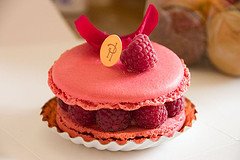Fusion or Confusion?

I fell upon European languages rather late in life. All of my limited grey capacity was required to tackle the tens of thousands Chinese characters in their traditional form. Whatever space was left in my head, I filled it with useless information. Luckily, food has always occupied most of that leftover space so I became a fluent restaurant linguist long before my first language class.
Being an Asian woman, I never had any problem in Paris not speaking their tongue - no, I don't count mastering what is in a Berlitz pocket book as speaking French. In those days, I reasoned: as long as I could understand restaurant menus, fill my suitcase with Diptyque candles and Mariage Frères' teas, scoff macarons from Pierre Hermé, what more could a girl need on her sojourns?
It was pure serendipity that I chose Italian as my first foray into the romance languages. It is an enjoyable language, I love hearing it, having the vowels roll out of my mouth; and it brought me many beautiful experiences, not all food related...plus a great bonus which I never expected: I can now read and understand French recipes! Since I am most interested in baking, almost all recipes are fairly simple. Still, never had I dreamt that one day I could nibble homemade Sablés au Citron à la Fleur de Sel or Langues de Chat with my "Dragonball" Jasmine tea.
A few years ago I couldn't have guessed that I would spend a good part of my day reading in five languages, and mostly about food. This fetish is now reflected in how we eat: homemade pesto and tomato passata are constants but so are green curry paste, satay sauce, sweet miso and mirin; and since I have banned commercial biscuits at home, there is always something sweet for Guillermo's merienda (afternoon snack): a melting slab of sablé, a slice of cake or a mochi filled with aduki bean paste.
I am greatly amused by Guillermo's new favourite; Chinese spiced salt (the sand-colour kind in which you dip your deep fried chicken) with everything, including tortilla de papa (Spanish potato omelette)! Then, there are times when it doesn't seem so funny to me - he adds cheese to my Northern Chinese dumplings as they are essentially ravioli made with an egg less pasta! The man has a point.
Ever since I bit into my first Ispahan (see picture) - a delicate sculpture of rose macaron, lycee and raspberries, I have been collecting recipes from the maestro, Pierre Hermé. There is no doubt he is French but his Ligurian lemon cake is damn dreamy.
Pierre Hermé' s Ligurian Lemon Cake
For the lemon cake:
100g unsalted butter, melted
1 3/4cups plain flour
1 1/2 tsps baking powder
1 3/4cups plain flour
1 1/2 tsps baking powder
1 cup granulated sugar
Zest of 2 lemons, very finely chopped
4 large eggs, room temperature
3 tbsps milk, room temperature
1 tbsp freshly squeezed lemon juice (about 1/2 lemon)
2/3 cup extra-virgin olive oil
1 punnet of fresh raspberries
For the meringue:
1 large egg white
1/4 cup granulated sugar
Icing sugar, for dusting
To make the cake, preheat oven to 180C with rack in center. Butter a 10-inch round cake or springform tin, dust with flour, and tap out any excess. In a large bowl, sift flour and baking powder; set aside.
Place sugar and lemon zest in the bowl of an electric mixer; rub the ingredients together between your fingers until the sugar is moist, grainy, and has absorbed as much of the zest as possible. Return bowl to mixer. Using the whisk attachment, beat in eggs on medium high until the mixture is pale and thick, about 3 minutes.
With the mixer on lowest speed, beat in milk. Add reserved flour mixture; beat until incorporated. Add lemon juice, melted butter, and olive oil; beat until blended.
Pour about one third of the batter into the prepared tin; there should be just enough batter to form a thin, even layer. Arrange the raspberries on top of the batter. Pour the remaining batter over the raspberries, and use a rubber spatula to gently spread batter so that it runs down between the berries and just covers them (you'll have a very thin top layer of batter).
Bake cake until it's golden and pulling away from the sides of the tin, and a cake tester inserted into the center comes out clean, 30 to 33 minutes. Remove the cake from the oven, and immediately unmold it onto a wire rack.
Invert cake so it is right side up to cool to room temperature. Once cooled, the cake is ready to serve or to be decorated with meringue.
Make the meringue and assemble the dessert: Preheat oven to 240C with rack in the center. Place the cooled cake on a parchment-lined baking sheet, and set aside. In the clean, dry bowl of an electric mixer fitted with the whisk attachment, beat egg white until it holds soft peaks. Add granulated sugar in a slow, steady stream; continue beating until firm, glossy peaks form. Using a metal icing spatula or a butter knife, immediately spread the meringue over the top of the reserved cake. Dust the meringue with icing sugar.
Bake the cake until lightly browned, 4 to 6 minutes. Garnish the cake with more raspberries, if desired, and serve.
Pierre Hermé, 72 rue Bonaparte and 185 rue de Vaugirard, Paris
The New Otani and Laporte Aoyama, Tokyo


<< Home